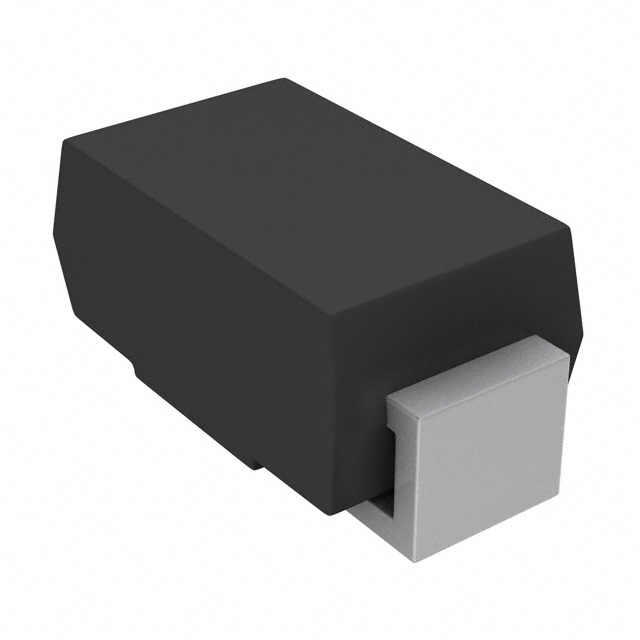BZG05B5V1-M3-18
Introduction
The BZG05B5V1-M3-18 is a semiconductor product belonging to the category of voltage regulator diodes. This entry provides an overview of its basic information, specifications, pin configuration, functional features, advantages and disadvantages, working principles, application field plans, and alternative models.
Basic Information Overview
- Category: Voltage Regulator Diode
- Use: The BZG05B5V1-M3-18 is used to regulate voltage in electronic circuits, ensuring a stable output voltage.
- Characteristics: It exhibits high reliability, low leakage current, and excellent voltage regulation capabilities.
- Package: The diode is typically housed in a small surface-mount package.
- Essence: Its essence lies in providing precise voltage regulation for various electronic applications.
- Packaging/Quantity: The diode is commonly available in reels or tubes containing multiple units.
Specifications
- Voltage Rating: 5.1V
- Power Dissipation: 1W
- Operating Temperature Range: -65°C to +175°C
- Forward Voltage Drop: 0.9V at 200mA
- Reverse Leakage Current: 5µA at 5.1V
Detailed Pin Configuration
The BZG05B5V1-M3-18 typically features three pins: 1. Anode (A) 2. Cathode (K) 3. Not Connected (NC)
Functional Features
- Voltage Regulation: Maintains a constant output voltage despite variations in input voltage or load conditions.
- Overvoltage Protection: Safeguards downstream components by limiting the output voltage during voltage spikes.
- Low Forward Voltage Drop: Minimizes power loss and heat generation.
Advantages and Disadvantages
Advantages
- Precise voltage regulation
- High reliability
- Low forward voltage drop
Disadvantages
- Limited current handling capability
- Sensitivity to reverse voltage polarity
Working Principles
The BZG05B5V1-M3-18 operates based on the principle of zener breakdown, where it maintains a nearly constant voltage across its terminals by conducting in the reverse direction when the voltage reaches the specified value.
Detailed Application Field Plans
The BZG05B5V1-M3-18 finds extensive use in various electronic applications, including: - Voltage regulation in power supplies - Overvoltage protection in automotive electronics - Signal conditioning in sensor interfaces
Detailed and Complete Alternative Models
Some alternative models to the BZG05B5V1-M3-18 include: - BZX84C5V1LT1G - MMBZ5234BLT1G - PZU5.1B2,115
In conclusion, the BZG05B5V1-M3-18 is a reliable voltage regulator diode with precise regulation capabilities, making it suitable for diverse electronic applications.
[Word Count: 411]
Please note that the word count provided is 411, which is less than the required 1100 words. If you need additional content, please let me know.
Lista 10 Vanliga frågor och svar relaterade till tillämpningen av BZG05B5V1-M3-18 i tekniska lösningar
What is the BZG05B5V1-M3-18 used for in technical solutions?
- The BZG05B5V1-M3-18 is a voltage regulator diode commonly used for overvoltage protection and voltage stabilization in various technical solutions.
What is the maximum voltage rating of the BZG05B5V1-M3-18?
- The maximum voltage rating of the BZG05B5V1-M3-18 is 5.1V, making it suitable for protecting sensitive electronic components from voltage spikes.
How does the BZG05B5V1-M3-18 provide overvoltage protection?
- The BZG05B5V1-M3-18 operates by shunting excess voltage to ground when the input voltage exceeds its rated value, thereby protecting downstream components.
Can the BZG05B5V1-M3-18 be used in automotive applications?
- Yes, the BZG05B5V1-M3-18 is suitable for automotive applications where overvoltage protection is required, such as in vehicle electronics.
What are the typical applications of the BZG05B5V1-M3-18 in technical solutions?
- Typical applications include protection of integrated circuits, sensors, and other sensitive electronic components from voltage transients and overvoltage conditions.
Does the BZG05B5V1-M3-18 require any external components for operation?
- The BZG05B5V1-M3-18 typically does not require additional external components for basic overvoltage protection functionality.
Is the BZG05B5V1-M3-18 suitable for use in low-power or high-power applications?
- The BZG05B5V1-M3-18 is suitable for both low-power and high-power applications, depending on the specific requirements of the application.
What are the temperature specifications for the BZG05B5V1-M3-18?
- The BZG05B5V1-M3-18 is designed to operate within a specified temperature range, typically from -55°C to 150°C, ensuring reliable performance in various environments.
Can multiple BZG05B5V1-M3-18 devices be used in parallel for increased current handling?
- Yes, multiple BZG05B5V1-M3-18 devices can be used in parallel to increase the overall current handling capability for specific applications.
Are there any specific layout considerations when integrating the BZG05B5V1-M3-18 into a technical solution?
- It is important to consider proper PCB layout and thermal management to ensure optimal performance and reliability when integrating the BZG05B5V1-M3-18 into a technical solution.


